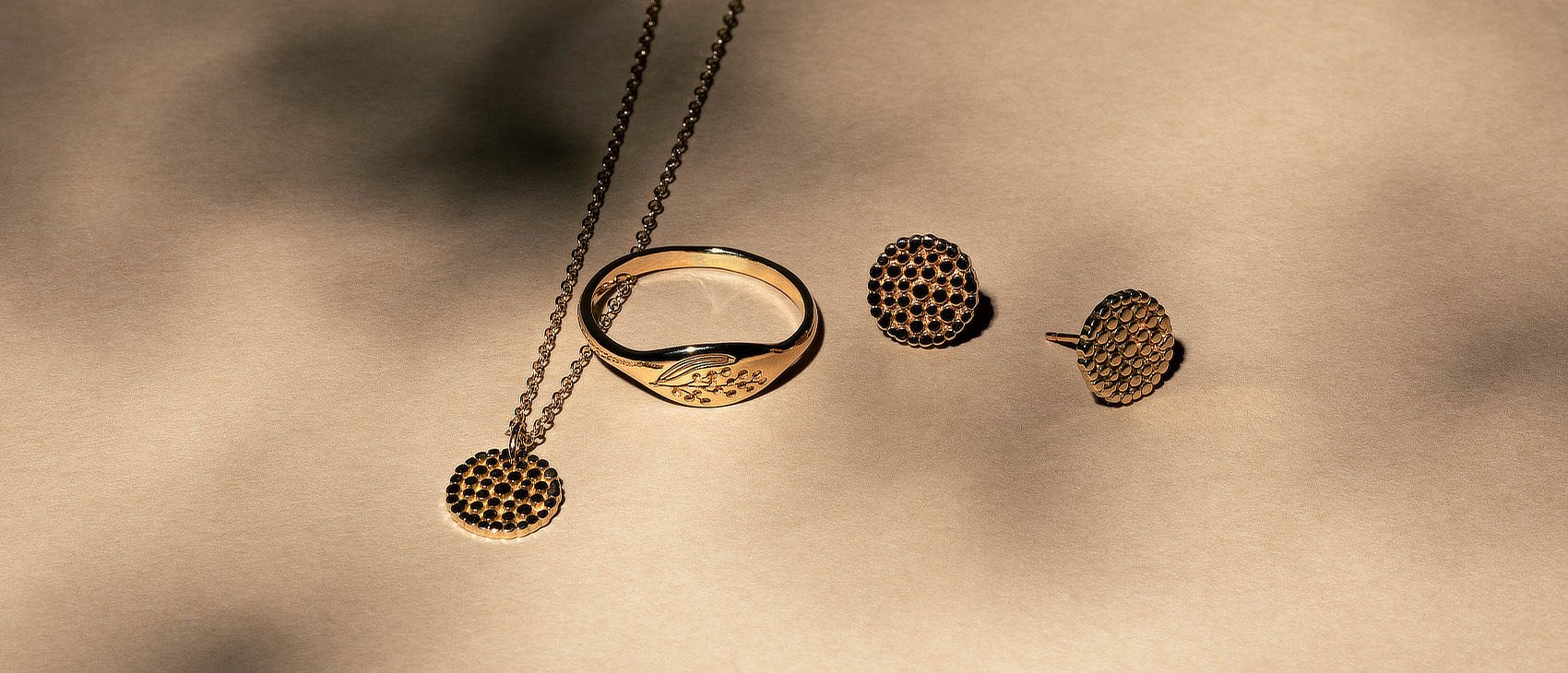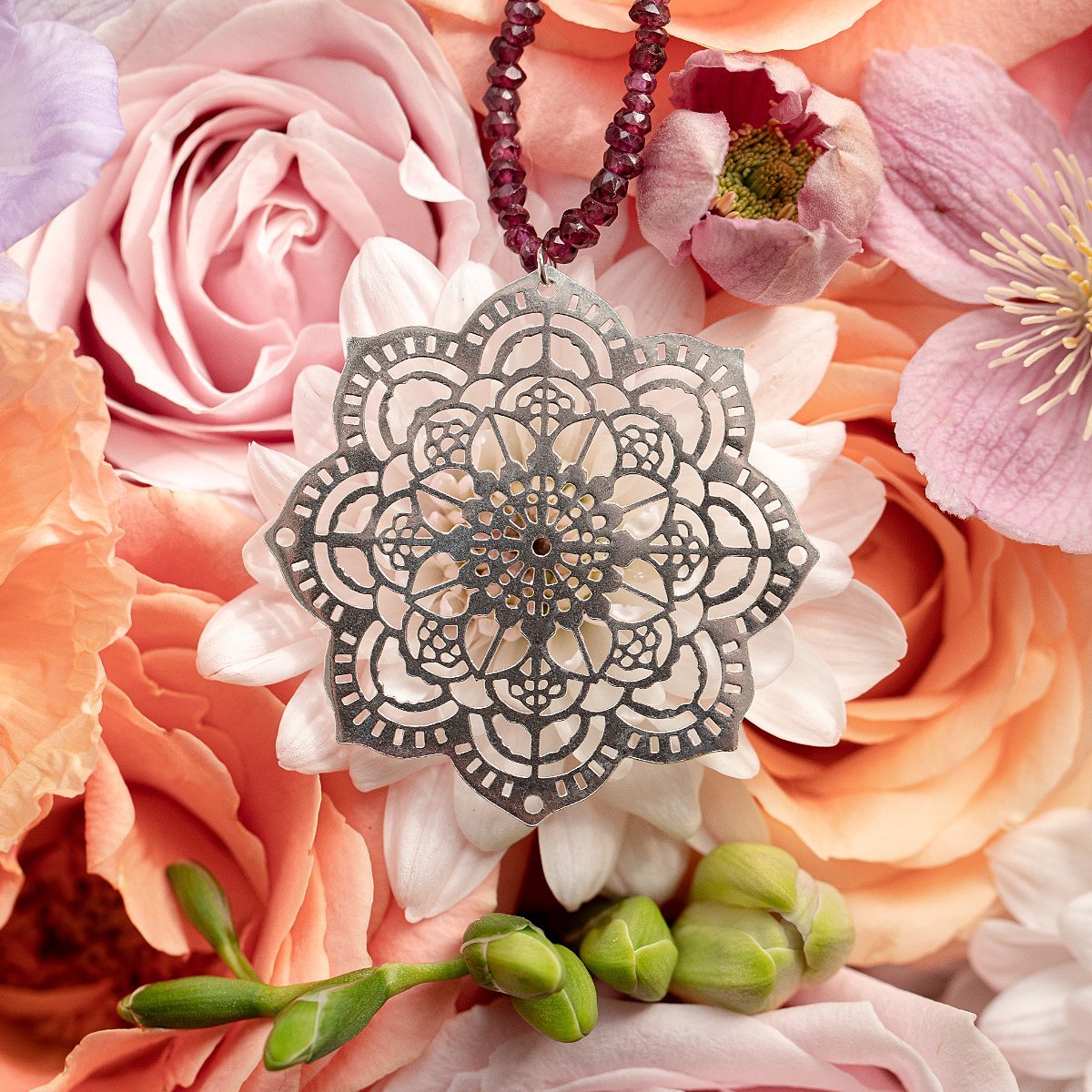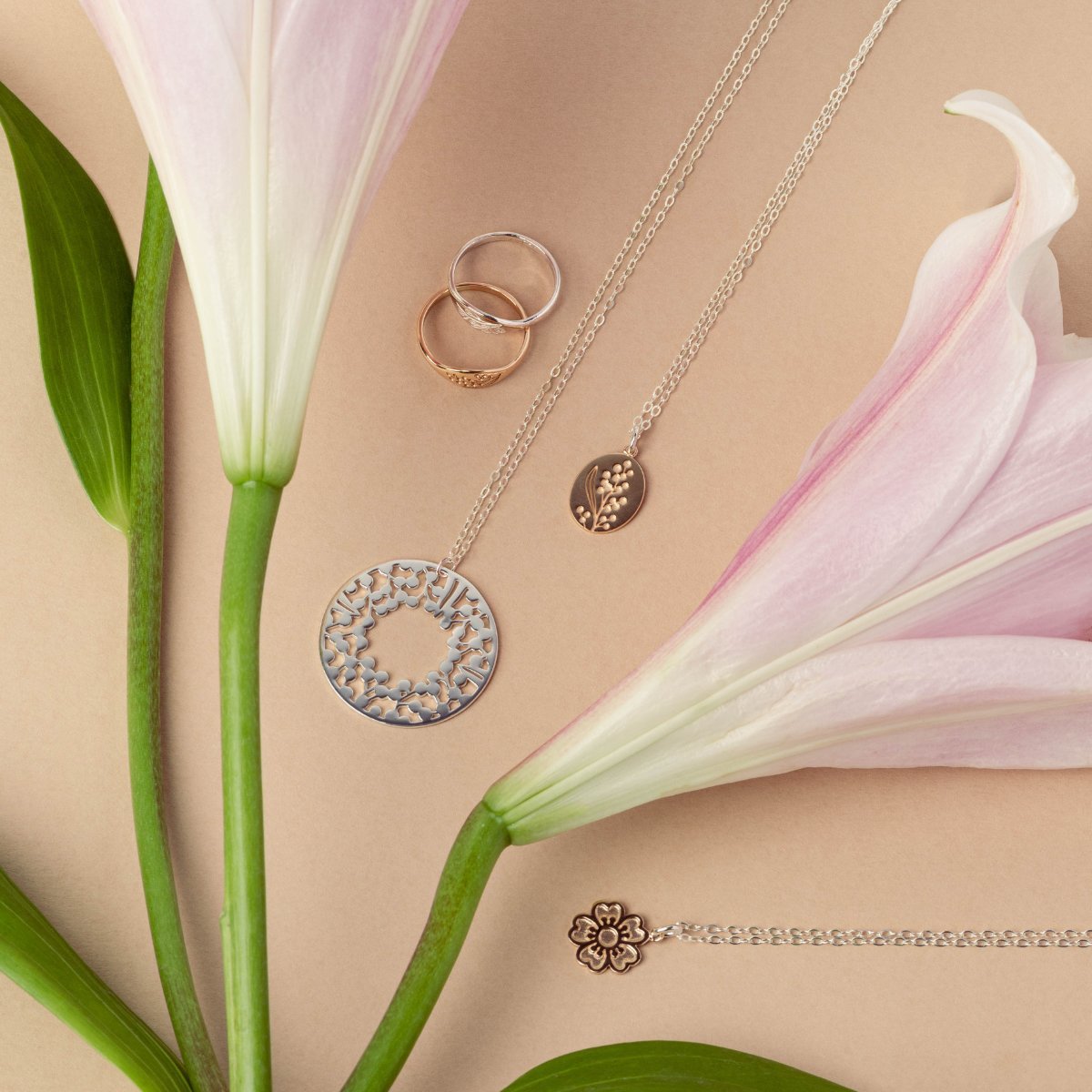 Imagine this: you're getting ready for a special occasion. Your outfit is perfect, your makeup is flawless, and you reach for your favourite piece of sterling silver jewellery to complete the look ... only to find it covered in a dark stain. What now?
Imagine this: you're getting ready for a special occasion. Your outfit is perfect, your makeup is flawless, and you reach for your favourite piece of sterling silver jewellery to complete the look ... only to find it covered in a dark stain. What now?
Silver jewellery is beautiful and valuable, but without proper care, tarnish will quickly dull its shine. This is a natural process, but fortunately learning how to clean silver jewellery is simple, and with a few easy techniques, you can restore your favourite silver pieces to their original brilliance.
As a jewellery designer and maker with over 30 years of experience crafting silver jewellery, I've seen it all when it comes to tarnish and cleaning methods.
In this guide, I'll walk you through the safest and most effective ways to clean silver jewellery while dispelling common myths. Plus, I'll share my top tips to prevent tarnish in the first place.
Looking for beautiful new jewellery? Explore our sterling silver earrings, silver necklaces, and sterling silver rings. Also see our full sterling silver jewellery collection.
Let's get started by looking at what tarnish is (and what it isn't), so you're better informed when it comes to caring for your precious jewellery.
PS. This guide is specifically about cleaning silver jewellery. Also see our comprehensive Jewellery Cleaning & Care Guide which covers other metals and gemstones.
What is Silver Tarnish?
Silver tarnish is a chemical reaction that occurs when silver interacts with compounds in the air, most commonly sulphur, forming a dark oxide layer. Tarnish is a normal, natural chemical reaction: it is not a fault and it doesn't mean the silver in your jewellery is poor quality.
Here's a more technical explanation according to Wikipedia: tarnish is a product of a chemical reaction between a metal and a non-metal compound, most commonly oxygen and sulphur dioxide, which forms a metal oxide (and sometimes metal sulphide or chloride) on the metal.
The good news? Tarnish is purely a surface reaction and doesn't damage the precious metal underneath. Tarnish might appear to be yellow, brown, grey or black in colour and is not the same as rust.
Sterling silver is 92.5% pure silver alloyed with copper for the added durability needed to make jewellery.
Sterling silver tarnishes more easily and more darkly than pure silver because of the copper content. Even fine silver (99.9% pure) can develop a dull, grey patina over time and it's also not suitable to make jewellery as it's too soft and will easily bend.
Learn more in our handy guide to What is Sterling Silver?.
Green Discolouration on Silver
If you see a green, usually powdery residue on sterling silver, this is known as verdigris. It's rarely seen on sterling silver, but will be the result of a chemical interacting with the copper content in the silver alloy.
In my experience this most commonly happens when residue from a cleaning process is left behind on the silver for some time. Work through the cleaning methods below to remove it and take extra care with rinsing your jewellery after cleaning.
What Causes Silver to Tarnish?
Tarnish is almost impossible to avoid completely, but some things can certainly speed up the process, including:
- Prolonged exposure to free flowing air and dust
- Humidity and air pollution
- Perfumes, lotions, and makeup
- Soaps and hand creams
- Chlorine (pools, hot tubs, bleach cleaning products - these can also stain the metal)
- Skin's natural oils and pH levels (for some people more than others)
When it comes to tarnish, the best thing you can do is to slow it down as much as you can. I'm sure you'll agree that prevention is always better than ... cleaning! Keep reading below for my top tips to avoid tarnish on silver jewellery.
Now that you know what causes tarnish, keep reading to explore how to clean silver jewellery properly, both at home and with professional help (including an important tip!).
How to Clean Silver Jewellery
Different levels of tarnish and grime require different cleaning methods. Here are the best ways to clean silver jewellery, starting with the gentlest and working up to more intensive techniques. I'll also give you my top tip for engaging a professional jewellery cleaning service, which is always the safest cleaning option.
A note: take extra care when cleaning silver plated jewellery, which will have a base metal under the thin plated surface. Plating can easily wear through and then you'll have more complicated problems. I don't recommend purchasing regular plated jewellery if you can avoid it, especially silver.
1. Soap and Water (For Light Dirt Removal)
Silver doesn't just tarnish: it gets dusty, grimey and collects debris. Your jewellery gets up close and personal with your body and environment, sometimes for many hours at a time on a very regular basis. As with your clothes and similar personal items, your jewellery simply needs cleaning from time to time.
The easiest and safest way to clean silver jewellery is with warm water and a gentle, fragrance-free soap, such as Castile soap. This won't remove tarnish, but it's still a great step to get your jewellery clean, whether it needs tarnish removal or not. Take some time periodically to just give your jewellery a wash.
How to do it:
- Mix warm water with a few drops of a gentle, fragrance-free liquid soap.
- Use a soft cloth or soft-bristled brush to gently clean the jewellery.
- Rinse thoroughly with clean water.
- Dry immediately with a soft cloth.
2. Ultrasonic Cleaning (For Heavier or Complex Dirt Removal)
As with soap and water, ultrasonic cleaning won't remove tarnish or polish your jewellery, but it will make it very clean and harder gemstones especially will sparkle.
Using an ultrasonic is helpful with complex pieces with crevices, or if your jewellery is very gummed up with grime and debris because it hasn't been cleaned in a long time (this is what some jewellers jokingly refer to as 'lady glue' or 'man glue'!).
There are some small and quite decent domestic ultrasonic cleaners on the market these days and if you own a fair bit of jewellery, it's probably a good idea to pick one up. I use mine very frequently.
Related Reads:
However, using an ultrasonic - even a lower powered domestic one - comes with a few risks to be aware of.
How not to do it:
- Don't put soft gemstones (eg. pearls, opal, lapis lazuli, turquoise) into an ultrasonic: they may be damaged.
- If you know a gemstone has a significant flaw or crack in it, also don't use an ultrasonic or it may fall apart.
- Avoid using an ultrasonic for blackened, antiqued or other patinated metals: it may damage or remove these finishes.
- Avoid having the silver rattle directly against the metal surface of the ultrasonic - especially for longer cleans - as this may scratch the silver. Use wire or string to hang the piece into the solution if needed.
Always follow the instructions that come with your ultrasonic cleaner, but here's a rundown of the basic process.
How to do it:
- Use preferably warm water with a small amount of gentle, fragrance-free liquid soap mixed in.
- If your ultrasonic has different power strengths, start with the gentlest and see how it goes.
- Once clean, rinse your jewellery well and dry it with an ordinary soft cloth.
- You might want to return your jewellery to the ultrasonic after using a tarnish removal method to get rid of remnants of cleaning compound or fluff from a polishing cloth. Just repeat the same steps as above.
3. Silver Polishing Cloth (For Shine & Light to Moderate Tarnish)
A good quality silver polishing cloth is an essential piece of kit for every jewellery lover. It will do a great job of removing most regular tarnish and has the benefit of adding shine to your jewellery. Even I'm still surprised at what a great job a simple but good quality polishing cloth can do to revive a tarnished piece of silver jewellery!
I suggest starting with a polishing cloth before trying more intensive cleaning methods: it may well do the job for you without the mess associated with some cleaning methods, along with the need for potentially more abrasive or harsher chemicals.
Our professional quality Sunshine Jewellery Polishing Cloth will do an excellent job of removing tarnish and adding shine. The cloths are impregnated with tarnish removing polishing compound and can be used with all precious metals. This is another product I frequently use myself.
Good quality polishing cloths are generally safe to use, but there are a few precautions to be aware of.
How not to use
- Avoid rubbing the cloth directly on gemstones (especially soft stones: opals, pearls, etc.) as it may scuff them.
- For jewellery with deliberately blackened or patinated surfaces, be cautious to clean around these areas to not remove the finishing.
- Never rub too hard when polishing precious metals.
How to use:
- Gently rub the jewellery with the cloth: avoid rubbing too hard as you may scuff the metal.
- Turn the cloth frequently to avoid spreading tarnish.
- Rinse the jewellery in clean water to remove polishing residue, using a gentle soap if needed.
- Dry immediately with an ordinary soft cloth.
- Do not wash the polishing cloth as it will lose its effectiveness.
- Once the cloth is completely black, it will need replacing.
4. Silver Cream, Polish or Paste (For Moderate to Heavy Tarnish)
If your silver is more heavily tarnished or has crevices you can't reach with a polishing cloth, then silver cream, polish or paste can be your friend. However, pastes and polishes in particular may be more abrasive than other methods, so take some care.
These are also messier cleaning methods, so will likely require you to use gloves and do some cleaning up afterwards.
We recommend finding a good quality polish, cream or paste which is specifically intended to clean silver: polish which is intended to work with an array of metals (and especially brass or other base metals) is likely to be much more abrasive. My preference would be to use a silver cream for the least abrasive clean.
Be sure to read and follow the instructions on the silver cleaning product you use, but below are the likely steps.
How to use:
- Wearing gloves is recommended.
- Apply a small amount to a soft cloth or use the one provided.
- Gently rub the jewellery, moving to cleaner sections of the cloth and adding more paste/cream as needed.
- Rinse the pieces periodically so you can more clearly see how it's going.
- Once clean, rinse very thoroughly with water and some gentle soap if needed.
- Dry thoroughly with an ordinary soft cloth.
5. Electrochemical Silver Cleaning (For Heavier Tarnish)
This homemade method uses a chemical reaction to help remove tarnish. However, we also don't recommend using this method on silver that has been blackened, antiqued or has another patina as it may remove these finishes.
For particularly heavy tarnish, you might find this method 'loosens' the tarnish enough so that a polishing cloth or other method can be used afterwards to finish the job.
What you need:
- A glass or ceramic bowl lined with aluminium foil
- 1 cup hot water
- 1 tbsp salt
- 1 tbsp baking soda
- 1 tbsp gentle, fragrance-free liquid soap
How to do it:
- Mix the ingredients in the bowl.
- Place the jewellery on top of the foil and let it sit for 5-10 minutes.
- Rinse thoroughly and repeat as needed with a fresh batch.
- For a gentler second round, you could also try using a polishing cloth again at this point, following the steps above.
- Dry your jewellery with a soft cloth.
6. Silver Dip (For Moderate to Heavy Tarnish)
Silver dips chemically remove tarnish fast and without rubbing, making them a quick and easy solution. Dips can also get into details and crevices that a polishing cloth - or even creams, polishes or pastes - just can't get to.
That might sound great, but silver dip is a harsh chemical and should be used with caution. I recommend you use a good quality silver dip only occasionally on appropriate pieces that really need it, as it may damage the surface of the metal with more regular use.
How not to do it:
- Avoid dipping softer gemstones, like pearls, opals or lapis lazuli (pearls especially).
- Avoid dipping blackened, antiqued or other patinated metals: it may damage or remove these finishes.
- Don't leave your jewellery in the dip for more than a few seconds at a time, unless the instructions say otherwise.
- Don't skip the step of rinsing well in water and drying.
- Don't let the liquid come into contact with your skin or other surfaces.
You should always follow the instructions on the product when using it, but below is an overview.
How to do it:
- Dip the jewellery for a few seconds.
- Rinse very thoroughly with clean water.
- Dry immediately with a soft cloth.
- Repeat as needed for heavier tarnish, but don't overdo it.
- You can also try using a polishing cloth again after dipping, following the steps above.
7. Use a Professional Jewellery Cleaning Service (For All Levels of Tarnish)
Most people prefer to clean their silver jewellery at home. However, for pieces that are complicated in some way (soft precious stones, very delicate design, etc.) or are highly sentimental, valuable or have extremely bad tarnish, we recommend taking them to a professional for cleaning.
Many fine jewellery stores and manufacturing jewellers offer a cleaning service. It will likely come with a cost, but for an important piece that you love, it will be the safest option for cleaning silver: the work will be done by a professional, using the most suitable methods and materials.
Important Tip:
Give your jewellery a clean with a gentle soap and water (see above) before taking it to a professional for cleaning or repair. You wouldn't take dirty clothes to a clothing alteration service, but jewellers often have to deal with very grimey jewellery brought to them by customers.
So do them a favour and give your jewellery a quick wash first - or even use an ultrasonic cleaner for very dirty pieces if the jewellery is suitable (also see above). Trust me: any jeweller will truly, madly and deeply appreciate the effort you've made.
Silver Cleaning Myths: How Not to Clean Jewellery
So I've run you through my recommended cleaning techniques, but a quick search of the internet will reveal a raft of other 'homemade silver cleaning' methods using everyday ingredients you likely have already.
In my opinion, most of these are problematic and they are not recommended by silver conservation or jewellery professionals. The exception is the electrochemical silver cleaning method above.
If you're in a jam and urgently need to clean your jewellery just this one time, then you might find these other methods will get you out of trouble if you're very careful. However, I do not recommend using them at all if you can avoid it.
Some of the methods to avoid include:
- Baking / bicarb soda paste: too abrasive
- Toothpaste: ditto
- Vinegar: too acidic and may damage gemstones
- Lemon juice: ditto
- Baking soda & vinegar combined: same issues as above, plus the fizz looks impressive but it doesn't actually do anything.
- Olive oil mixture: leaves a sticky residue that may be difficult to remove and will attract dust and grime
- Glass cleaner: too harsh
- Any combination of the above
How to Prevent Tarnish on Silver Jewellery
You can take preventative steps to slow down tarnish. Nothing will completely avoid it, but you can certainly make it less of a problem.
1. Wear Your Jewellery
Wearing silver regularly actually helps keep tarnish at bay. However, if your particular skin's pH reacts easily with silver (which is the case for a small number of people), then you may need to clean your jewellery more often or even choose a different type of metal to wear.
2. Store Your Jewellery Properly
- Keep silver in a closed container, out of free flowing air: this is the best way to most easily reduce tarnish.
- Don't display your jewellery on an open stand or rack: it will get dusty and silver will tarnish easily. Such displays can look great, but they don't do your jewellery any favours.
- Use anti-tarnish strips or silica gel packets: putting some gel packets that come with other products in your jewellery storage container can help.
- Avoid leaving jewellery humid areas like bathrooms: humidity and being in the open air is a perfect recipe for ... tarnish.
All of our Australian jewellery comes in eco-friendly gift boxes. These are a perfect for storing individual pieces of silver jewellery.
3. Avoid Contact with Chemicals
- Remove jewellery before swimming in a pool or salt water.
- It's also a good idea to remove it before showering or bathing.
- Don't wear jewellery when exercising as sweat build up can cause tarnish and other issues (or clean it soon after).
- Also remove jewellery from your hands when using cleaning products, especially harsh ones and particularly bleach.
- Put jewellery on after applying makeup and perfumes.
(Reading this on a website that isn't simonewalsh.com? Be aware that the content has been stolen, infringing the copyright of a small business. ABN: 65108844126)
Final Thoughts
With the right care and cleaning routine, your silver jewellery will stay beautiful for years to come. The key is gentle and regular maintenance — and storing your jewellery properly. I recommend setting time aside at least twice a year to check your jewellery, clean it and remove tarnish if needed.
Looking to expand your silver jewellery collection? Explore our stunning range of sterling silver jewellery today.
Other reads:
- Understanding Silver Tarnish
- Caring For Silver: very useful read for antique silver especially
- Pros & Cons of Gold & Silver Plated Jewellery



 Handmade Silver Stackable Rings
Handmade Silver Stackable Rings 
 Silver Statement Necklaces
Silver Statement Necklaces Simone Walsh is a
Simone Walsh is a 
